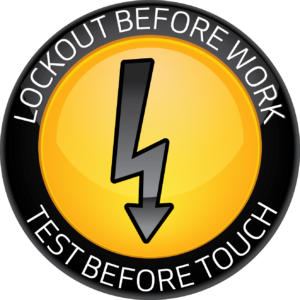Electricity behaves the same no matter what country you are in. It doesn’t matter whether you are in the Americas or Europe, Asia or Africa. It also doesn’t matter whether you are an electrician, a researcher, an engineer, or even an office worker who performs occasional household repairs. If you make contact with a hazardous live circuit part, your life will be at risk. In this sense, mere compliance to local national regulations matters less than understanding basic electrical safety principles. This page in particular is intentionally written without any regulatory or compliance language.
 |
If you don’t do anything else,then at least do this! |
Principle 1: Work only on dead equipment whenever possible
Working on live electrical equipment can be extremely hazardous. Most installations and repairs can and should be performed dead, not live. This is a changed expectation that grew out of a recognition that too many workers were getting killed or seriously hurt by working on or near live electrical equipment. It used to be a job expectation for electricians to perform live installations and repairs. Not anymore! We have learned, the hard way, that taking the time to properly shut down equipment in order to work dead not only saves lives, but also time and money in the long run. Employers who ask their employees to make live repairs often do not understand the risk involved to their people or to their business. Working live should only be done as a last resort and where working dead in not possible, such as for some types of testing and troubleshooting.
Principle 2: Lock it out to prevent reenergization
A fundamental aspect of working dead, along with Principle #3, is to control the sources of hazardous energy. Without proper control, the equipment could be inadvertently reenergized while people are working on it. This could be devastating. A fundamental best practice in electrical safety is to padlock the isolation switch or breaker to maintain the isolation throughout the entire duration of work. This process is called Lockout, or Lockout/Tagout (LOTO).
Many countries and employers have highly developed Control of Hazardous Energy programs that define when and how to lock out equipment. A solid lockout policy will require individual locks for each employee and written lockout procedures when more than one isolation point is required. Each individual is responsible for locking out and protecting their own life. Conversely, an employer is also responsible for implementing an effective lockout policy.
Principle 3: Test it before you touch
Hazardous voltage cannot be detected by a human sense before it is too late. Do not rely on the noise going away, or the lights going off. It could still be live. Do not rely on your own knowledge either. Most people who get a shock are surprised: they were 100% convinced that the circuit was dead. However, they didn’t perform a test to verify.
A proper test for absence of voltage, sometimes called a Zero Voltage Verification (ZVV), is always conducted with a contact multimeter or similar voltage tester. In order to verify the meter is in proper working order, the meter must be checked on a known live source BEFORE AND AFTER the zero voltage measurement. This is called the LIVE-DEAD-LIVE procedure. Remember, even a bad meter can read zero voltage, so you have to prove your meter is working.
Principle 4: Ensure you have the proper qualifications
Electrical safety requires a fairly solid technical understanding. Various countries and local administrations define qualified in different manners. This could be licensing, completion of an apprenticeship, formal education, on the job training, or a combination of all of these. Ultimately, one thing matters: are you competent enough to work on the system to recognize the hazards? Do you know which parts are/could be live, and to what voltage? Can you recognize when things are wrong? Can you follow a circuit diagram to help in your troubleshooting efforts? Do you know how to properly select the right tools and personal protective equipment (PPE) necessary for the task? Finally, do you have the hands-on experience and body positioning techniques to keep you safe?
A properly qualified person should be able to reply YES to these questions, and be comfortable doing so. Conversely, every qualified person should also be aware of their own limitations. Nobody knows everything, and sometimes we need to seek out assistance from someone with a different skill set or level of knowledge.
What’s missing? What about PPE (Personal Protective Equipment)?
Wearing proper PPE is of course necessary when working on equipment that is or could potentially be energized. This can include shock protection and/or arc flash protection. However, PPE is the LAST line of defense. It is never acceptable to just put people into PPE and sent them to work. PPE will instead be specified after a proper analysis of the job scope and of the hazards involved. A good risk assessment will identify ways to eliminate or reduce risk such that PPE is not always necessary.